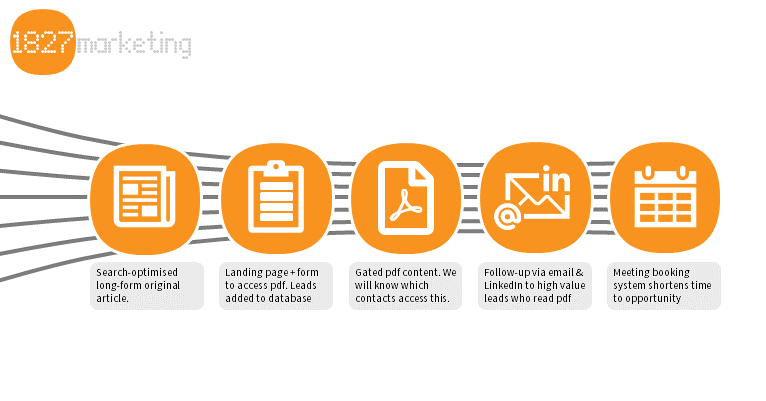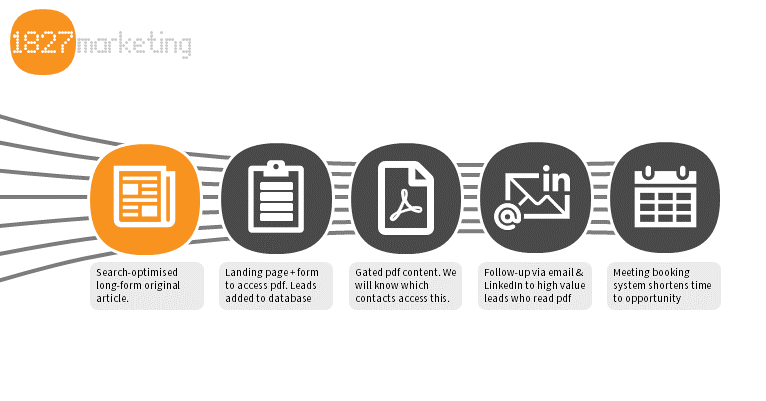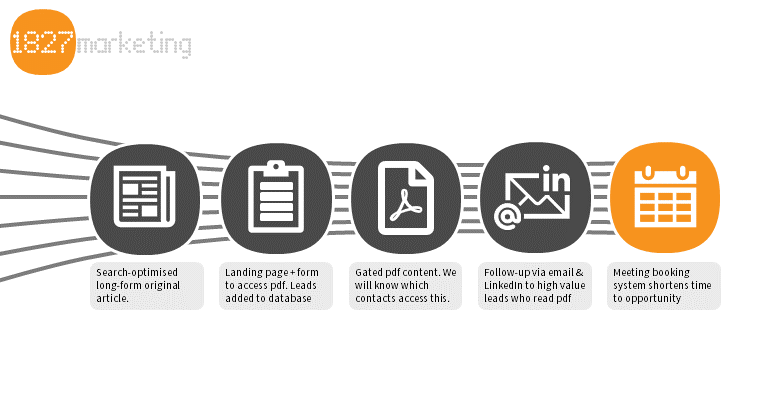Accelerate the B2B Buyer Journey with Marketing Automation - Part 1
Effective content marketing depends on the integration and interdependency of content, automation and inbound channels. If you were to plot this idea on paper, it would look like two connected axes. The core elements of content marketing lie on the X-axis. It’s what happens when prospects find you. Inbound channels stack along the Y - this is how prospects find you. The flow between the groups is what makes a successful content marketing programme.
We created this visualisation of content marketing axes explain how we would simplify, streamline, and automate our clients’ content and remarketing efforts.
In this article, Part 1 of The Axes of Content Marketing, we consider the core elements' value and function. In Part 2, we walk through how inbound channels animate those elements within your marketing strategy.
The Core Elements of Content Marketing
The core elements are mechanisms to build an audience and move customers from the first touch to the final transaction. You cannot do anything with inbound channels until you have these core elements in place and a plan to keep producing. Along the X-axis of content marketing, you'll find deliverables and the processes needed to create them:
Engaging content for each stage in the customer journey
A focused landing page with one clearly defined goal
Marketing automation to personalise the customer experience
Painless booking to quicken sales
Core Element #1: Engaging Content for Each Stage in the Customer Journey
Content is customer experience. It's often the first step in a person's journey to becoming a customer.
This statement is our mantra and it is more accurate now than ever before. When the depth of professional relationships hinges on the quality of digital interactions, a customer's first touch is the most crucial conversion.
How to Create Engaging Content
When we build content for our clients, we first transform brand positioning and messaging into a content strategy with pillars. A pillar is a central theme, usually associated with a competitive keyword, around which we build the content calendar. Before we develop the article briefs at the heart of the calendar, we perform two sets of keyword and SERP (search engine results page) analysis:
Keywords related to brand messaging and positioning
Keywords related to each article topic
Our findings inform the on-page SEO efforts included in the brief for our writers to execute. By placing the brand in an organic search context, we ensure that content will satisfy the target customer's queries.
Gated vs Ungated Content in the Customer Journey
An article built for organic search may answer a user question but need not be actionable all the time. That's because search articles are intended for the awareness stage of the customer journey. When a user finds your article via search engine, they might not know your brand. But they are aware of the problem or question they just Googled.
Gated content works best as a lead-generating tool when it's actionable. We create gated content for customers in the consideration or decision stage of the buyer journey. They are beyond awareness, and they're now actively looking for ways to remedy their situation. In the form of a well-designed PDF, panel, or webinar, gated content should provide actionable steps to accomplish the customer's goal.
Core Element #2: Build a Focused Landing Page
A landing page is a page of action.
In exchange for access to gated content, a user must provide their information. A streamlined and focused landing page makes the exchange effortless. When offering gated content, you'll want to create a type of landing page called a squeeze page. A squeeze page does precisely that: it squeezes the necessary information in and everything else out. It exists in a vacuum of your creation; it focuses the user on the offer.
How to Create a Stellar Squeeze Page
There are five rules for building an effective landing page:
1. Single goal
If you're not clear about what you want from your user, they won't be either. Define the goal for the page. There should only be one (e.g., capture their email address, secure their registration, take a survey)
2. Single offer
You're not offering them everything. You're offering one single thing that you know will be of interest. Put all of your eggs in one basket.
3. Clear CTA
Leave no wiggle room. Clearly instruct them to take one action that will give them access to one offer that is the product of the page's one goal.
4. Pare down design
Severely streamline page design. You don't need navigational menus or decorative elements. You want them 100% focused on the page's offering.
5. Test options
Test everything: copy, headline, images, video, button placement. Less is more on a squeeze page, so be sure that you're getting the most you can.
Testing options and targeted personalisation has become easier, thanks to the automated deployment of dynamic landing pages. Dynamic landing pages used to be a luxury that required extra coding to create multiple versions of a single page. Thanks to software, personalised landing pages are now a standard feature in some marketing automation platforms. Like segmented emails speak to segmented audiences' needs and preferences, dynamic landing pages show different messaging to different users based on factors such as their industry, job role or seniority, and behavioural triggers.
Core Element #3: Understanding customer interactions on your site and responding appropriately
Get to know your customer well enough to anticipate their needs.
Giving the customer the information they need and the experience they expect is only one function of the content you create. It’s other function is to provide the data points you need to get to know people well enough so you can not only meet their expectations but anticipate them.
Our CRM holds the entire life of every lead. Every click, open, page view and download live there like a digital constellation pointing us in the right direction. With that information, we can both communicate with and remarket to real people, not best-guess avatars. In our gated content example, we will know if someone has accessed the pdf download. That means we can automate a follow-up email to ask what they thought and if they’d like to talk more about it, or we can send a prompt to a team member to follow up in person. That follow up can lead to booking meetings, which is the next step in this customer journey.
With every interaction, our picture of them becomes more precise and more refined, enabling us to really hone in on the questions they’re trying to answer.
This helps us to understand when to reach out to them, whether via social media, email or a call. It also means that we're confident we know what they want and can provide information they’ll find relevant.
Core Element #4: Marketing Automation to Strengthen Relationships and Refine Remarketing
Give your team their time and creativity back.
Marketing automation is what enables us to use our customer intelligence and build relationships at scale. Automation refers to a suite of integrated tools and services that perform the repetitive yet vital tasks your marketing strategy relies on. With these tedious tasks taken care of, your team has the time and creativity to generate more leads and nurture the best prospects. They have the time to do what (human) marketers and salespeople do best.
Marketing automation platforms, such as SharpSpring, offer a host of functions designed to integrate and streamline your remarketing, analytics, follow-up, and sales processes. Some of these features include:
Built-in CRM and sales automation
Campaign tracking
Landing page builder
Website interaction tracking
End to end reporting and analytics
Social media management
Behaviour-based email
The Value of Marketing Automation
Marketing automation simplifies workflows and centralises information for in-house teams. It also has immense value for strengthening individual prospect relationships, segmenting markets, and leveraging content across inbound channels.
Marketing segmentation
In the same way our CRM strengthens individual relationships, it can also segment our entire customer base in powerful ways. The life of a lead creates a series of attributes that AI helps us to make sense of. With segments based on an infinite combination of data points, we deploy email sequences and social media campaigns to meet customers at any point along their buyer's journey.
Nurturing relationships
Our decision on what kind of interaction or information to offer our target audience is based on based on the data gathered in our automation platform.
For example, an automated lead score can tell you if a client is "warm" enough for a 1:1 follow-up. If your contact has reached a pre-determined lead score threshold your sales team receives a notification to get in touch. And a holistic view of that individual’s interactions with your company can tell you whether they are more likely to engage with that follow up via LinkedIn message, email or telephone.
However, if a potential client isn't ready for 1:1 follow-up then behavioural triggers and workflows can help to deliver personalised information and nurture the relationship for a bit longer. Regardless of the type of follow-up, the automated platform's data helps identify the most effective next step to keep the customer moving towards conversion.
Leveraging engaging content across channels
Marketing automation also complements our content marketing with automated social posts. We use software to extract key sentences from our articles and create year long campaigns on our social platforms. This level of automation, especially on Twitter (the most voracious and unrelenting feed), gives us enviable flexibility with our content calendar. Because we know that AI is continually feeding the social beast with our original content we have the flexibility to be strategic and timely with additional content and campaigns.
Core Element #5: Painless Booking for Quicker Sales
Every part of the customer journey should be quick and frictionless for all parties.
What's the biggest buzzkill for the customer in the sales process? A long email thread to coordinate a meeting time when they're ready to buy. Don't brush off this core element because it's a minor detail. It doesn't make sense for the top of your funnel to champion customer experience if it's going to stall (or fall apart) at the point of sale with a real member of your team. If you don't use a marketing automation tool with a built-in meeting scheduler, you can choose a dedicated appointment booking software such as Calendly or MeetingBird.
The Misconceptions and Limitations of Marketing Automation
There are a few caveats to mention about marketing automation. While automation helps us build relationships at scale more efficiently, it cannot replace the human touch. An automation platform is complementary to and integrated with our marketing strategy as a whole. It's a tool to make the lives of actual humans more rewarding. It's not a tool to replace their work.
Likewise, automation isn't appropriate for every interaction, especially when it comes to follow-up steps. We've worked with clients to create consideration stage campaigns where behaviour-based email automation made sense as a follow-up to a piece of gated content. We've also created strategies where the outcome would have been damaged by decision-stage follow-ups that felt less than 100% personal. Even though automation platforms can deliver beautifully formated, personalised email campaigns at exactly the right moment, sometimes the most effective automation is zero-automation.
The team at 1827 Marketing are experts at integrating the axes of content marketing. We offer a suite of services to simplify, streamline, and amplify marketing campaigns for digital B2B clients. Book a demo to explore how we can help your brand improve the customer journey with engaging, relationship building content and marketing automation for a quicker sales process.
In Part 2 of The Axes of Content Marketing, we focus on growing your audience and customer base with the fundamentals of inbound channels.









Large language models are revolutionising content creation. This guide demystifies prompt engineering, providing actionable best practices for B2B marketers